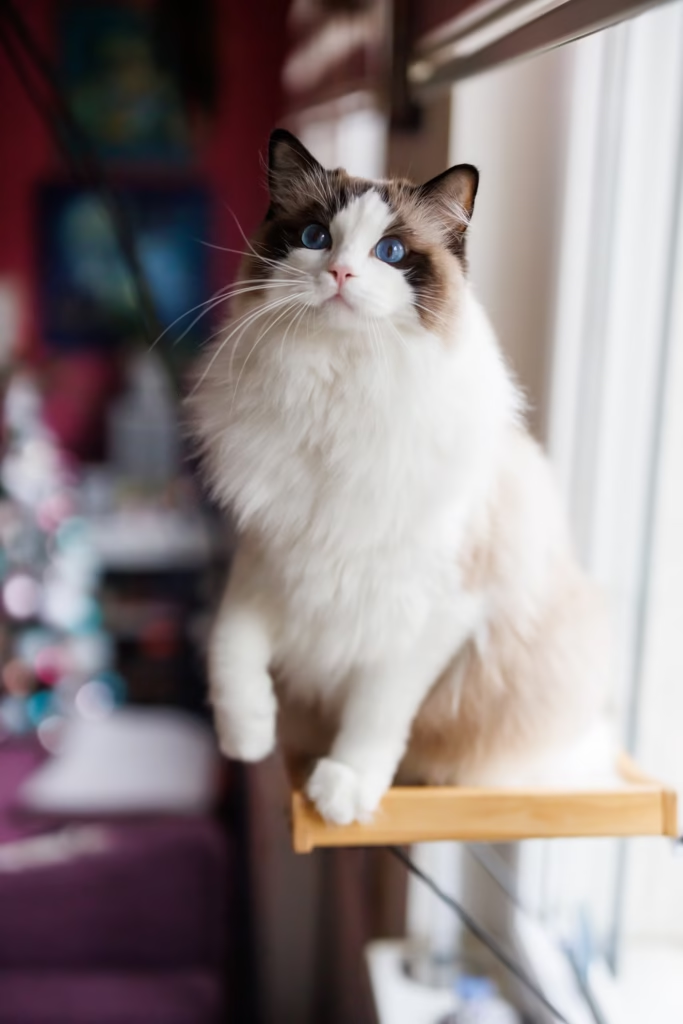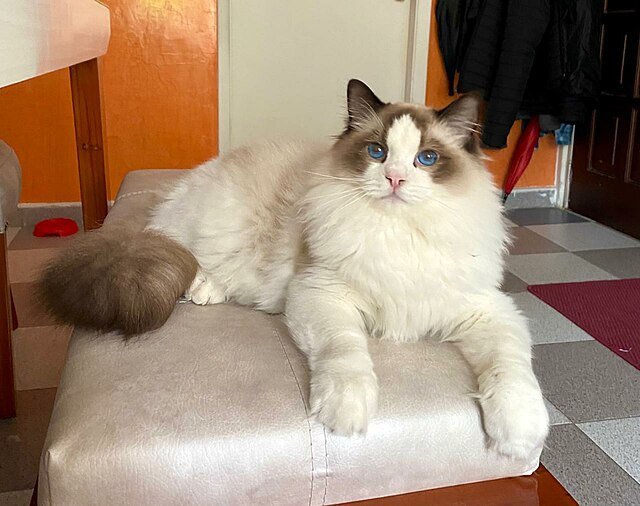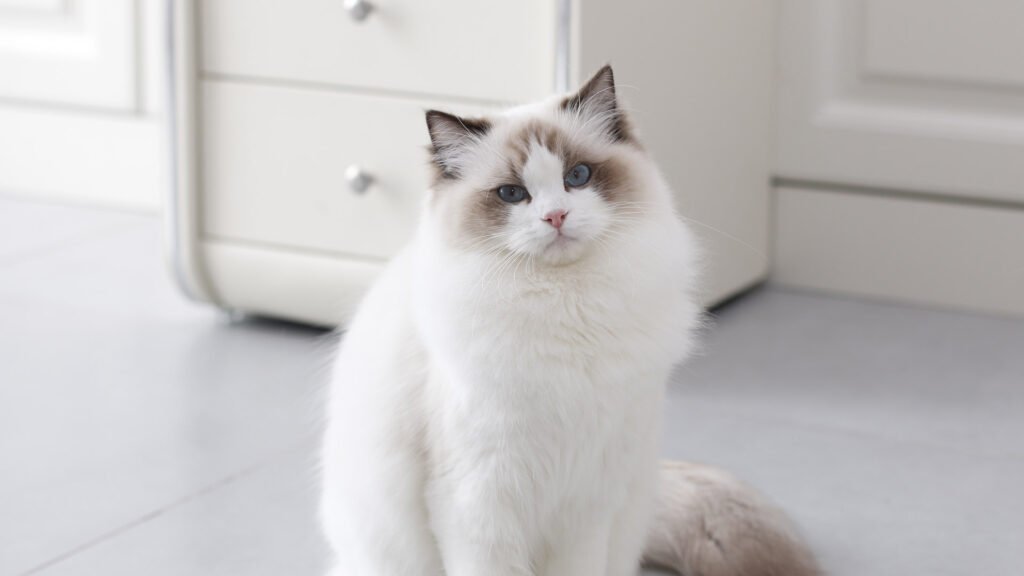Ragdoll
The Ragdoll cat breed is widely admired for its captivating appearance and gentle temperament, making it one of the most popular feline companions in households around the world. This breed, characterized by its striking blue eyes, semi-long hair, and affectionate nature, was developed in the 1960s in California. Ragdolls are large cats, often reaching weights between 10 to 20 pounds, and their physical dimensions contribute to their regal presence.

One of the most distinguishing features of the Ragdoll is its coat, which is soft and plush, resembling that of a rabbit. The fur is typically color-pointed, meaning that the extremities, including the ears, face, paws, and tail, are darker than the body. Common color patterns include mitted, bicolor, and colorpoint, each showcasing a different distribution of color and white markings. The luxurious coat requires regular grooming to prevent matting and to keep it looking its best.
Ragdolls are known for their docile and laid-back personality, traits that make them especially endearing to cat lovers. They tend to be sociable and enjoy the company of humans as well as other pets. Often described as “puppy-like,” Ragdolls are known to follow their owners around and seek affection, making them excellent companions for families and individuals alike. Their calm demeanor and adaptability contribute to their growing popularity as a breed, enticing many to consider them as their next pet.
In summary, the Ragdoll cat breed’s combination of striking physical characteristics, gentle personality, and affectionate behavior makes it a favored choice among cat enthusiasts. This introduction serves as a glimpse into the Ragdoll’s unique attributes, setting the stage for a more detailed exploration of this exceptional breed.

Personality
Ragdoll cats are renowned for their affectionate and gentle nature, making them one of the most sought-after feline companions. They possess a unique temperament characterized by their docile demeanor and sociable behavior. This breed is particularly well-known for its tendency to form deep bonds with individuals and families, often displaying an unwavering loyalty akin to that of a dog. Many Ragdoll owners report that their pets enjoy following them around the home, showcasing the breed’s desire for companionship and interaction.
One of the most endearing traits of Ragdoll cats is their tendency to be “puppy-like” in their behavior. They often prefer to be close to their human caregivers, seeking out attention and affection. This makes them especially suitable for families with children, as Ragdolls tend to be patient and tolerant, engaging in gentle play without exhibiting aggressive tendencies. Their calm nature allows them to coexist harmoniously with other pets, further enhancing their appeal as family companions.
Additionally, Ragdolls are known for their laid-back personality that enables them to acclimate easily to various living situations. Whether in a bustling household filled with activity or a quiet apartment, these cats adapt well while maintaining their friendly disposition. Their social nature means they thrive on interactions, often displaying a playful yet affectionate attitude towards both humans and other pets. This breed’s gentle and loving characteristics foster a nurturing environment, contributing to a delightful companionship experience for all family members.
Overall, Ragdoll cats epitomize the ideal domestic feline, combining an affectionate nature with a calm temperament. Their sociability and adaptability make them treasured members of countless households, reinforcing their status as one of the most beloved cat breeds. In summary, understanding the personality traits of Ragdolls helps prospective owners appreciate the delightful qualities they bring into a home.
Origins
The Ragdoll cat, known for its distinctive appearance and docile temperament, traces its origins back to the 1960s in California. The breed was developed by Ann Baker, a breeder who aimed to create a feline that possessed both captivating beauty and an affectionate personality. Baker’s journey began when she crossed a domestic longhaired cat with a white Persian and a Birman, resulting in what would eventually become the Ragdoll breed.

Ann Baker’s breeding program focused on specific traits that would define the Ragdoll. She desired cats that were not only visually striking but also exhibited a unique disposition. The name “Ragdoll” was inspired by their tendency to go limp when held, reflecting their gentle nature. This characteristic made them particularly appealing to families and individuals seeking a loving companion.
As the breed continued to gain traction, it spread beyond California to various parts of the world. Ragdolls were introduced into breeding programs across North America and Europe, contributing to their diverse genetic background. This exchange not only expanded their genetic pool but also enhanced the breed’s popularity, leading to their eventual recognition by various cat registries. Today, Ragdolls are celebrated not just for their beauty but also for their gentle and affectionate nature, making them one of the most beloved cat breeds globally.
Care of the Ragdoll cat
Providing the proper care for Ragdoll cats is essential to ensure their health and happiness throughout their lives. Given their medium to long fur, grooming is a significant part of their care routine. Regular brushing, ideally several times a week, helps prevent matting and reduces shedding, thus minimizing hairball formation. Ragdolls are known for their gentle temperament, so grooming can also serve as a bonding activity. Using a wide-toothed comb or a pin brush can make the grooming process enjoyable for both the owner and the cat.
Dietary needs also play a key role in maintaining the overall wellness of Ragdoll cats. High-quality cat food that is rich in protein is crucial, as these cats have a relatively high metabolism. It is advisable to look for foods specifically formulated for their age, whether they are kittens, adults, or seniors. Regularly consulting with a veterinarian can help ensure you are meeting their dietary needs as per their developmental stage. Additionally, fresh water should always be accessible to keep your Ragdoll hydrated.
Health considerations for Ragdoll cats should not be overlooked. Regular veterinary check-ups can aid in early detection of any potential health issues. Vaccinations, parasite control, and dental care are all vital components of their medical care. Furthermore, Ragdolls are highly social animals, so proper socialization with other pets and family members is important. Creating an enriched environment that provides plenty of play opportunities and stimulation contributes to their psychological well-being. Toys, climbing trees, and scratching posts can help satisfy their playful nature. Overall, understanding these care aspects will not only enrich the lives of Ragdoll cats but also nurture a strong bond with their owners.
Health
Ragdoll cats are generally healthy but can be prone to heart disease (HCM), bladder stones, and obesity. Regular vet check-ups, a balanced diet, and proper grooming help maintain their well-being. Learn how to keep your Ragdoll happy and healthy!
Nutrition
Ragdoll cats thrive on a high-protein, low-carb diet rich in essential nutrients. Their large size and semi-long fur require quality animal-based proteins, omega-3 fatty acids, and hydration to support muscle health, a silky coat, and overall well-being. Opt for grain-free, wet, or raw food options to prevent obesity and digestive issues. Balanced nutrition ensures a happy, healthy Ragdoll with a long lifespan.
Clenaliness
Ragdoll cats are known for their soft, silky coats that resist matting, making them relatively low-maintenance in terms of cleanliness. Regular brushing (2–3 times a week) helps reduce shedding and hairballs. Unlike some long-haired breeds, their fur doesn’t tangle easily, keeping them naturally neat. They are meticulous self-groomers, but occasional baths can help maintain their plush appearance. Keeping their litter box clean ensures good hygiene and prevents odors.
Best cat breeds for kids
Ragdoll cats are one of the best cat breeds for kids due to their gentle, affectionate nature and playful temperament. Known for their striking blue eyes and soft, plush fur, Ragdolls love to be held and will often go limp in your arms. They are social, friendly, and patient, making them perfect companions for children. Their low-maintenance grooming needs and adaptability to family life further enhance their appeal. If you’re looking for a loving and kid-friendly cat breed, the Ragdoll is an excellent choice!
People who have seen this breed have also visited…
In this section you can find completely detailed information about the breed of your cat.
